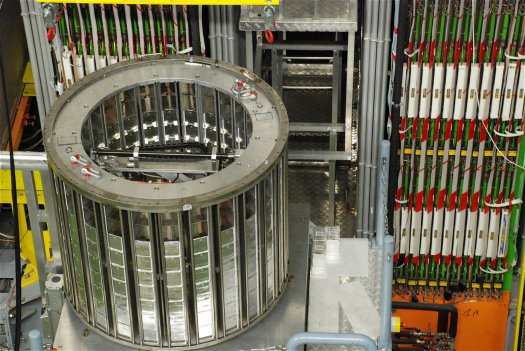Baffling CERN Results Show Neutrinos Moving Faster Than the Speed of Light That's really fast
Don’t go throwing out your physics texts just yet, but there’s some strange and unprecedented news brewing at CERN today that could potentially undo large parts of the Standard Model, and it has nothing to do with particle collisions at the LHC or elusive god particles. Physicists running routine neutrino experiments between CERN’s Geneva HQ and the Gran Sasso laboratory in Italy 455 miles away have found that their neutrinos seem to be traveling faster than the speed of light. That’s right: faster than the fastest known speed in the universe. It's certainly not something we could have predicted when putting together our latest FYI, which investigates whether anything can move faster than light.

The Loading Station at OPERA CERN
Just a refresher--not that you need it--but nothing travels faster than the speed of light. In physics-as-we-understand-them, it is the absolute and ultimate speed limit in our universe. We’ve tested and retested the speed of light, measured it in as many ways as we can think of, and much of modern physics is built upon the idea that nothing can exceed it.
So naturally this result is potentially huge. But, as noted above, it’s not yet time to tear down the whole of modern physics and start all over. Here’s what’s going on: CERN physicists are firing neutrinos--which don’t interact with normal matter and thus can pass straight through the earth--to a detector in Italy. The aim here was to test the frequency of oscillations (that’s when one flavor of neutrino spontaneously shifts to another flavor), so the Geneva team was sending a beam of muon neutrinos toward Gran Sasso, and the Gran Sasso team was recording how many ended up there as tau neutrinos.
But in doing so, they started to notice something odd. The neutrinos from CERN were showing up at Gran Sasso a few billionths of a second early--in other words, they appeared to be getting from Switzerland to Italy faster than light would travel the same distance.
This isn’t an isolated anomaly, but has been going on for years. The team has now measured some 15,000 batches of neutrinos coming across that distance, and they say they’ve reached a point where the statistical significance is such that, were they trying to prove anything else, it would count as as formal scientific discovery. But try as they might, they can’t explain what’s happening.
Nobody, least of all the researchers involved, is ready to call the Standard Model’s upper speed limit busted just yet. But they also can’t explain what’s happening, which is why they are opening up their data to scrutiny from the wider scientific community. So now we’ll have to wait and see if others in the physics world can replicate their results or come up with some kind of explanation as to why the neutrinos appear to be breaching a fundamental physical law.
Source: www.popsci.com